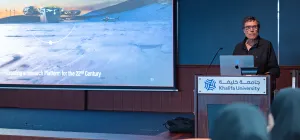Andy Delcloo and Preben Van Overmeiren Discus the BELSPO-Financed CLIMB Project

How do aerosol-CLoud Interactions influence surface Mass Balance in East Antarctica?
Find out more with the BELSPO-financed CLIMB project at the Princess Elisabeth Antarctica (PEA), with Andy Delcloo (RMI) and Preben Van Overmeiren (UGent)!
Context
The water cycle, cloud microphysics and cloud-aerosol-interactions are recognized as key elements of the Antarctic climate system. Clouds and aerosols play a significant role in the radiative energy budget. Aerosols impact cloud microphysics because they provoke cloud condensation and act as ice nuclei. In addition, clouds are an important part of the hydrological cycle, serving as a means of transporting water vapour to Antarctica via precipitation. Because precipitation is the only way mass can be added to the Antarctic Ice Sheet, thus incresing its surface mass balance (SMB), precipitation is therefore one of the key factors affecting global sea level. However, current knowledge on the interaction between clouds, precipitation and aerosols in the Antarctic is still limited, both from direct observations and from regional climate models.
At the Belgian research station Princess Elisabeth Antarctica (PEA), an observatory for aerosol, cloud and precipitation properties has been put in place. Preliminary results show a strong sensitivity of cloud microphysics to the number of ice-nucleating particles (INP), and to a lesser degree, to the number of cloud condensation nuclei (CCN) that form.
The CLIMB project does systematic measurements of INPs at PEA - combined with meteorological, aerosol and cloud microphysics observations – both at ground-level at the station and also at the typical precipitating cloud altitude. The aim is to improve the aerosol-cloud-precipitation parameterization in a regional climate model for East Antarctica.
Andy Delcloo from the Royal Meteorological Institute of Belgium (RMI), who is currently at PEA, has been verifying the skill score (how well a model performs) of the European Centre for Medium-Range Weather Forecasts (ECMWF) model. Andy is making on-demand forecasts for scientists in the field and at the station. It is vital for them to have the best available information to plan their missions. It is impressive to see how well the model can predict very specific weather phenomena here in Antarctica. Andy focuses on a lot on phenomena such as whiteouts, low cloud cover and probability of visibility, taking advantage of the ensemble forecast skills of the ECMWF model.
Also present at the station, colleagues from the Princess Elisabeth Antarctica Climate Experiment (PEACE) project, Derek Houtz and Simon Steffen (from the WSL in Zürich), are busy installing new automatic weather stations (AWS), which will soon be able to be consulted in near real-time. These seven stations will give us insight into the weather in near real-time from the Droning Maud Land coast to the Antarctic Plateau (along an almost 250 km transect). Together with atmospheric radio soundings launched from the station every two days, this will create added value for the operational numerical weather forecast models.
During their stay at PEA the scientists also installed a disdrometer at the station, an instrument that makes it possible to differentiate between different types of precipitation. On the Antarctic Plateau, we installed an OPS (Optical Particle Sizer instrument), which is powered by wind turbine and solar panels so that it can gather data continuously during the winter until the next BELARE expedition in 2022-2023.
Combined, these projects will give scientists a unique dataset and new information to help them estimate Antarctic mass balance, improve weather forecasting and closely monitor the changing climate!
Partners
The CLIMB project is coordinated by the Royal Meteorological Institute of Belgium (Dr. Alexander Mangold) with the following partners: Ghent University (research group EnVOC, Prof. Walgraeve), Katholieke Universiteit Leuven (KUL Department of Earth and Environmental Sciences, Prof. Nicole van Lipzig), and the Royal Belgian Institute for Space Aeronomy (IASB-BIRA, Dr. Michel Van Roozendael, UV-Vis DOAS Research). The Leibniz Institute for Tropospheric Research, (TROPO) in Leipzig, Germany, is a sub-contracted partner. CLIMB is financed by the Belgian Science Policy Office (BELSPO) BRAIN-be program.
Download





















